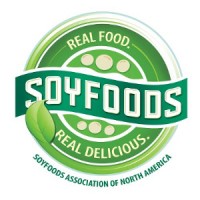Education
Use of soyfoods increasing in schools
- Details
- Published on Tuesday, 18 October 2016 15:01
- Written by PRNewswire
In honor of National School Lunch Week, the Soyfoods Association of North America applauds schools that offer soyfood options in their cafeterias. To meet growing demands for healthy, plant-based foods, schools nationwide are serving tofu, veggie burgers, soy crumbles, soymilk, soy yogurt, and other soyfoods.
School food service programs are increasingly taking advantage of the nutritional and economical value that soyfoods can provide their students. Soyfoods work within school meal requirements to offer a complete protein source that also supports fat and calorie reduction. Schools serve fortified soymilk in place of cow's milk, edamame as a vegetable, and tofu, soy-based deli slices, soy nuts, crumbles, burgers, soy nut butter or nuggets as meat alternatives.
This summer, USDA Food and Nutrition Service released four final rules required by the Healthy Hunger Free Kids Act to ensure snacks and marketing messages in schools are consistent with healthier school lunch and breakfast standards. These rules extend the school breakfast and lunch standards to foods sold throughout the school like vending machines, school stores, and a la carte items in the cafeteria. They also require schools to create wellness policies to promote health throughout the school.
Starting Early
For younger children, earlier this year the USDA released the final rule for the Child and Adult Care Food Program (CACFP), which updated meal patterns to include more whole grains, a greater variety of vegetables and fruits, and less added sugars and solid fats. It also stated that child care providers may now serve and get reimbursed for tofu, soymilk, and products made from these soyfoods as well as soy-based meat alternatives. Through the CACFP, more than 4 million children receive nutritious meals and snacks each day as part of the care they receive.
In a press release about the rule, Agriculture Undersecretary Kevin Concannon reiterated the importance of starting nutritious, delicious food at an early age. "Research indicates that America's obesity problem starts young, with obesity rates in preschoolers more than doubling over the last three decades and one in eight preschoolers classified as obese," Concannon said. "Since taste preference and eating habits develop early in life, CACFP could play a crucial role in the solution. This final rule marks another important step toward ensuring young children have access to the nutrition they need and develop healthy habits that will contribute to their well-being over the long term."
To comply with all these new rules, the USDA released a memo in August outlining for providers how to properly credit tofu and soy yogurt in the National School Lunch Program, School Breakfast Program, and the Child and Adult Care Food Program.
Providing nutritious food for children's growth and development is very important, and soyfoods can easily fit into the picture. Great-tasting soyfoods provide essential vitamins and minerals, such as iron, calcium, potassium and high-quality, complete protein for growing kids. These nutrients help kids build strong bones and lean muscle for balance and coordination, and serving soyfoods help kids learn to make healthy food decisions early in life.
Recent studies have indicated that eating soyfoods at an early age may protect against some diseases later on in life. For example, studies show eating soyfoods during childhood and adolescence may help protect against breast cancer as an adult. Soyfoods may also help preventing constipation, maintaining a healthy weight, and enduring athletic performance.
- Soy can provide high-quality protein without the high fat, saturated fat and cholesterol content of many animal protein sources. Soy protein is the only plant protein that contains all of the essential amino acids, just like animal protein.
- Soyfoods can help to manage weight, as they are an excellent source of low-fat, high-quality protein that has been shown to increase satiety—thought to be a key component of weight control. With more children having high blood cholesterols, the cholesterol lowering benefit of soy protein is an additional reason to use more often soyfoods in place of animal proteins.
- Soyfoods can deliver growth nutrients like iron, essential fatty acids and B vitamins. Many soyfoods are a great source of iron and soybeans are one of the only plant sources of essential Omega-3 fatty acids. Depending on the soyfood, they can also provide calcium, fiber, vitamins B and D, magnesium and potassium.
- Children fed soy-based formulas have been found to have normal endocrine and reproductive development. Some parents worry about exposure to estrogen compounds in soyfoods, but soy phytoestrogens are not human estrogens and have not been documented to result in precocious puberty. The Arkansas Children's Nutrition Center "Beginnings Study" found soy-formula-fed infants' growth and development patterns tracked closely with those of breast-fed infants. This study did not find any estrogenic effects in the soy-formula-fed infants during the first four months of life when development of reproductive organs is rapid.
- Allergies to soyfoods affect less than 1 percent of children and most grow out of them by age 10.The College of Allergy, Asthma, and Immunology estimates that approximately 0.4 percent of American children are allergic to soy, whereas the more prevalent allergies report milk (32 percent), followed by peanuts (29 percent), eggs (18 percent), and tree nuts (6 percent). Many schools and child care centers offer soy nuts and soy nut butter in place of peanuts, and serve soymilk in place of cow's milk to reduce potential exposure to severe allergens.

















































